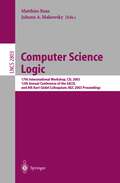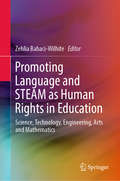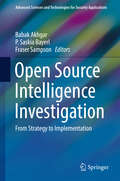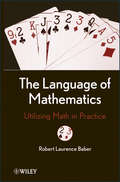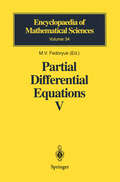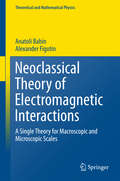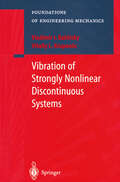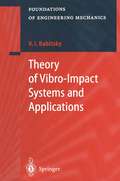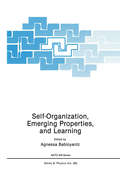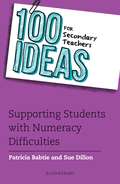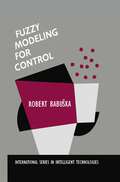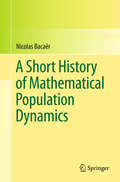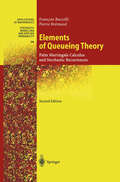- Table View
- List View
Methods of Cut-Elimination (Trends in Logic #34)
by Matthias Baaz Alexander LeitschThis is the first book on cut-elimination in first-order predicate logic from an algorithmic point of view. Instead of just proving the existence of cut-free proofs, it focuses on the algorithmic methods transforming proofs with arbitrary cuts to proofs with only atomic cuts (atomic cut normal forms, so-called ACNFs). The first part investigates traditional reductive methods from the point of view of proof rewriting. Within this general framework, generalizations of Gentzen's and Sch\”utte-Tait's cut-elimination methods are defined and shown terminating with ACNFs of the original proof. Moreover, a complexity theoretic comparison of Gentzen's and Tait's methods is given.The core of the book centers around the cut-elimination method CERES (cut elimination by resolution) developed by the authors. CERES is based on the resolution calculus and radically differs from the reductive cut-elimination methods. The book shows that CERES asymptotically outperforms all reductive methods based on Gentzen's cut-reduction rules. It obtains this result by heavy use of subsumption theorems in clause logic. Moreover, several applications of CERES are given (to interpolation, complexity analysis of cut-elimination, generalization of proofs, and to the analysis of real mathematical proofs). Lastly, the book demonstrates that CERES can be extended to nonclassical logics, in particular to finitely-valued logics and to G\"odel logic.
Computer Science Logic: 17th International Workshop, CSL 2003, 12th Annual Conference of the EACSL, and 8th Kurt Gödel Colloquium, KGC 2003, Vienna, Austria, August 25-30, 2003, Proceedings (Lecture Notes in Computer Science #2803)
by Matthias Baaz Johann M. MakowskyThis book constitutes the joint refereed proceedings of the 17th International Workshop on Computer Science Logic, CSL 2003, held as the 12th Annual Conference of the EACSL and of the 8th Kurt Gödel Colloquium, KGC 2003 in Vienna, Austria, in August 2003. The 30 revised full papers presented together with abstracts of 9 invited presentations were carefully reviewed and selected from a total of 112 submissions. All current aspects of computer science logic are addressed ranging from mathematical logic and logical foundations to the application of logics in various computing aspects.
Recent Advances in Statistical Research and Data Analysis
by Y. Baba A. J. Hayter K. Kanefuji S. KurikiRecent Advances in Statistical Research and Data Analysis is a collection of papers presented at the symposium of the same name, held in Tokyo by the Center for Information on Statistical Science of the Institute of Statistical Mathematics (ISM). Under the auspices of the Ministry of Education, Culture, Sports, Science and Technology of Japan, the ISM has created visiting professorships and organized symposia to promote collaboration between researchers from Japan and those from other countries. At the symposium on recent advances in statistical research and data analysis, the keynote speaker was Visiting Professor Anthony J. Hayter. This book includes Prof. Hayter's address as well as papers from special lectures that were presented at the symposium. All the contributions are concerned with theory and methodology for real data and thus will benefit researchers, students, and others engaged in data analysis.
Promoting Language and STEAM as Human Rights in Education: Science, Technology, Engineering, Arts And Mathematics
by Zehlia Babaci-WilhiteThis book argues that integrating artistic contributions – with an emphasis on culture and language – can make Science, Technology, Engineering and Mathematics (STEM) subjects more accessible, and therefore promote creativity and innovation in teaching and learning at all levels of education. It provides tools and strategies for managing interdisciplinary learning and teaching based on successful collaborations between researchers, practitioners and artists in the fields of the Arts and STEM subjects. Based on contributions by educators, scientists, scholars, linguists and artists from around the globe, the book highlights how we can demonstrate teamwork and collaboration for innovation and creativity in STEAM subjects in the classroom and beyond.The book reflects the core of human rights education, using local languages and local knowledge through art as a tool for teaching human rights at school, and bringing to light questions on diversity, ecology, climate change, environmental issues, health and the future of human beings, as well as power relations between non-dominant (minorities) and dominant (the majority) groups in society.
Open Source Intelligence Investigation: From Strategy to Implementation (Advanced Sciences and Technologies for Security Applications)
by Babak Akhgar, P. Saskia Bayerl and Fraser SampsonOne of the most important aspects for a successful police operation is the ability for the police to obtain timely, reliable and actionable intelligence related to the investigation or incident at hand. Open Source Intelligence (OSINT) provides an invaluable avenue to access and collect such information in addition to traditional investigative techniques and information sources. This book offers an authoritative and accessible guide on how to conduct Open Source Intelligence investigations from data collection to analysis to the design and vetting of OSINT tools. In its pages the reader will find a comprehensive view into the newest methods for OSINT analytics and visualizations in combination with real-life case studies to showcase the application as well as the challenges of OSINT investigations across domains. Examples of OSINT range from information posted on social media as one of the most openly available means of accessing and gathering Open Source Intelligence to location data, OSINT obtained from the darkweb to combinations of OSINT with real-time analytical capabilities and closed sources. In addition it provides guidance on legal and ethical considerations making it relevant reading for practitioners as well as academics and students with a view to obtain thorough, first-hand knowledge from serving experts in the field.
Integrable Systems: The Verdier Memorial Conference Actes du Colloque International de Luminy (Progress in Mathematics #115)
by V. Babelon P. Cartier Y. Kosmann-SchwarzbachThe Language of Mathematics: Utilizing Math in Practice
by Robert L. BaberA new and unique way of understanding the translation of concepts and natural language into mathematical expressions Transforming a body of text into corresponding mathematical expressions and models is traditionally viewed and taught as a mathematical problem; it is also a task that most find difficult. The Language of Mathematics: Utilizing Math in Practice reveals a new way to view this process—not as a mathematical problem, but as a translation, or language, problem. By presenting the language of mathematics explicitly and systematically, this book helps readers to learn mathematics¿and improve their ability to apply mathematics more efficiently and effectively to practical problems in their own work. Using parts of speech to identify variables and functions in a mathematical model is a new approach, as is the insight that examining aspects of grammar is highly useful when formulating a corresponding mathematical model. This book identifies the basic elements of the language of mathematics, such as values, variables, and functions, while presenting the grammatical rules for combining them into expressions and other structures. The author describes and defines different notational forms for expressions, and also identifies the relationships between parts of speech and other grammatical elements in English and components of expressions in the language of mathematics. Extensive examples are used throughout that cover a wide range of real-world problems and feature diagrams and tables to facilitate understanding. The Language of Mathematics is a thought-provoking book of interest for readers who would like to learn more about the linguistic nature and aspects of mathematical notation. The book also serves as a valuable supplement for engineers, technicians, managers, and consultants who would like to improve their ability to apply mathematics effectively, systematically, and efficiently to practical problems.
The Language of Mathematics: Utilizing Math in Practice
by Robert L. BaberA new and unique way of understanding the translation of concepts and natural language into mathematical expressions Transforming a body of text into corresponding mathematical expressions and models is traditionally viewed and taught as a mathematical problem; it is also a task that most find difficult. The Language of Mathematics: Utilizing Math in Practice reveals a new way to view this process—not as a mathematical problem, but as a translation, or language, problem. By presenting the language of mathematics explicitly and systematically, this book helps readers to learn mathematics¿and improve their ability to apply mathematics more efficiently and effectively to practical problems in their own work. Using parts of speech to identify variables and functions in a mathematical model is a new approach, as is the insight that examining aspects of grammar is highly useful when formulating a corresponding mathematical model. This book identifies the basic elements of the language of mathematics, such as values, variables, and functions, while presenting the grammatical rules for combining them into expressions and other structures. The author describes and defines different notational forms for expressions, and also identifies the relationships between parts of speech and other grammatical elements in English and components of expressions in the language of mathematics. Extensive examples are used throughout that cover a wide range of real-world problems and feature diagrams and tables to facilitate understanding. The Language of Mathematics is a thought-provoking book of interest for readers who would like to learn more about the linguistic nature and aspects of mathematical notation. The book also serves as a valuable supplement for engineers, technicians, managers, and consultants who would like to improve their ability to apply mathematics effectively, systematically, and efficiently to practical problems.
Partial Differential Equations V: Asymptotic Methods for Partial Differential Equations (Encyclopaedia of Mathematical Sciences #34)
by V. M. Babich N. S. Bakhvalov M. V. Fedoryuk A. M. Il'In V. F. Lazutkin G. Panasenko A. L. Shtaras B. R. VainbergIn this paper we shall discuss the construction of formal short-wave asymp totic solutions of problems of mathematical physics. The topic is very broad. It can somewhat conveniently be divided into three parts: 1. Finding the short-wave asymptotics of a rather narrow class of problems, which admit a solution in an explicit form, via formulas that represent this solution. 2. Finding formal asymptotic solutions of equations that describe wave processes by basing them on some ansatz or other. We explain what 2 means. Giving an ansatz is knowing how to give a formula for the desired asymptotic solution in the form of a series or some expression containing a series, where the analytic nature of the terms of these series is indicated up to functions and coefficients that are undetermined at the first stage of consideration. The second stage is to determine these functions and coefficients using a direct substitution of the ansatz in the equation, the boundary conditions and the initial conditions. Sometimes it is necessary to use different ansiitze in different domains, and in the overlapping parts of these domains the formal asymptotic solutions must be asymptotically equivalent (the method of matched asymptotic expansions). The basis for success in the search for formal asymptotic solutions is a suitable choice of ansiitze. The study of the asymptotics of explicit solutions of special model problems allows us to "surmise" what the correct ansiitze are for the general solution.
Elastic Waves: High Frequency Theory (Chapman & Hall/CRC Monographs and Research Notes in Mathematics)
by Vassily Babich Aleksei KiselevElastic Waves: High Frequency Theory is concerned with mathematical aspects of the theory of high-frequency elastic waves, which is based on the ray method. The foundations of elastodynamics are presented along with the basic theory of plane and spherical waves. The ray method is then described in considerable detail for bulk waves in isotropic and anisotropic media, and also for the Rayleigh waves on the surface of inhomogeneous anisotropic elastic solids. Much attention is paid to analysis of higher-order terms and to generation of waves in inhomogeneous media. The aim of the book is to present a clear, systematic description of the ray method, and at the same time to emphasize its mathematical beauty. Luckily, this beauty is usually not accompanied by complexity and mathematical ornateness.
Elastic Waves: High Frequency Theory (Chapman & Hall/CRC Monographs and Research Notes in Mathematics)
by Vassily Babich Aleksei KiselevElastic Waves: High Frequency Theory is concerned with mathematical aspects of the theory of high-frequency elastic waves, which is based on the ray method. The foundations of elastodynamics are presented along with the basic theory of plane and spherical waves. The ray method is then described in considerable detail for bulk waves in isotropic and anisotropic media, and also for the Rayleigh waves on the surface of inhomogeneous anisotropic elastic solids. Much attention is paid to analysis of higher-order terms and to generation of waves in inhomogeneous media. The aim of the book is to present a clear, systematic description of the ray method, and at the same time to emphasize its mathematical beauty. Luckily, this beauty is usually not accompanied by complexity and mathematical ornateness.
Neoclassical Theory of Electromagnetic Interactions: A Single Theory for Macroscopic and Microscopic Scales (Theoretical and Mathematical Physics)
by Anatoli Babin Alexander FigotinIn this monograph, the authors present their recently developed theory of electromagnetic interactions. This neoclassical approach extends the classical electromagnetic theory down to atomic scales and allows the explanation of various non-classical phenomena in the same framework.While the classical Maxwell–Lorentz electromagnetism theory succeeds in describing the physical reality at macroscopic scales, it struggles at atomic scales. Here, quantum mechanics traditionally takes over to describe non-classical phenomena such as the hydrogen spectrum and de Broglie waves. By means of modifying the classical theory, the approach presented here is able to consistently explain quantum-mechanical effects, and while similar to quantum mechanics in some respects, this neoclassical theory also differs markedly from it. In particular, the newly developed framework omits probabilistic interpretations of the wave function and features a new fundamental spatial scale which, at the size of the free electron, is much larger than the classical electron radius and is relevant to plasmonics and emission physics.This book will appeal to researchers interested in advanced aspects of electromagnetic theory. Treating the classical approach in detail, including non-relativistic aspects and the Lagrangian framework, and comparing the neoclassical theory with quantum mechanics and the de Broglie–Bohm theory, this work is completely self-contained.
Vibration of Strongly Nonlinear Discontinuous Systems (Foundations of Engineering Mechanics)
by V.I. Babitsky V.L. KrupeninThis monograph addresses the systematic representation of the methods of analysis developed by the authors as applied to such systems. Particular features of dynamic processes in such systems are studied. Special attention is given to an analysis of different resonant phenomena taking unusual and diverse forms.
Theory of Vibro-Impact Systems and Applications (Foundations of Engineering Mechanics)
by Vladimir I. Babitsky- Models of vibro-impact systems are widely used in machine dynamics, vibration engineering, and structural mechanics. - Only monograph on this subject in English language. - Systematically presents the theory of vibro-impact systems by analysis of typical engineering applications. - Experimental data and computer simulations are presented. - Targeted to engineers and researchers in design and investigation of mechanical systems as well as to lecturers and advanced students.
Self-Organization, Emerging Properties, and Learning (Nato Science Series B: #260)
by Agnessa BabloyantzThis volume contains the proceedings of the workshop held in March 1990 at Austin, Texas on Self-Organization, Emerging Properties and Learning. The workshop was co-sponsored by NATO Scientific Affairs Division, Solvay Institutes of Physics and Chemistry, the University of Texas at Austin and IC2 Institute at Austin. It gathered representatives from a large spectrum of scientific endeavour. The subject matter of self-organization extends over several fields such as hydrodynamics, chemistry, biology, neural networks and social sciences. Several key concepts are common to all these different disciplines. In general the self-organization processes in these fields are described in the framework of the nonlinear dynamics, which also governs the mechanisms underlying the learning processes. Because of this common language, it is expected that any progress in one area could benefit other fields, thus a beneficial cross fertilization may result. In last two decades many workshops and conferences had been organized in various specific fields dealing with self-organization and emerging properties of systems. The aim of the workshop in Austin was to bring together researchers from seemingly unrelated areas and interested in self-organization, emerg{ng properties and learning capabilities of interconnected multi-unit systems. The hope was to initiate interesting exchange and lively discussions. The expectations of the organiziers are materialized in this unusual collection of papers, which brings together in a single volume representative research from many related fields. Thus this volume gives to the reader a wider perspective over the generality and ramifications of the key concepts of self organization.
100 Ideas for Secondary Teachers: Supporting Students with Numeracy Difficulties (100 Ideas for Teachers)
by Patricia Babtie Sue DillonDyscalculia experts Patricia Babtie and Sue Dillon present 100 ideas to help students with numeracy difficulties grasp the core skills required in the secondary curriculum, not just in maths but in other subjects including science, design and technology, computing and geography.Around 25 per cent of secondary school students have severe numeracy difficulties. These students are often anxious and fearful about using maths arising from a repeated failure to learn. This impacts their overall attainment. Patricia and Sue show how numeracy difficulties can be overcome using multi-sensory teaching and helping students with their study skills, revision and exam techniques. This dip-in-and-out book provides activities and games to encourage students to explore numerical ideas and discover underlying patterns across the secondary curriculum. These ideas help to develop an understanding of maths concepts and see their relevance in everyday life.100 Ideas for Secondary Teachers: Supporting Students with Numeracy Difficulties contains adaptable ideas that are relevant across the curriculum. It will help build confidence in learners, making it a must-have resource for all schools.
Understanding Dyscalculia and Numeracy Difficulties: A Guide for Parents, Teachers and Other Professionals
by Patricia Babtie Jane EmersonDyscalculia is a specific learning difficulty that affects the acquisition of numerical skills. A far larger number of pupils, while not dyscalculic, fail to acquire the basic numerical skills required for everyday life. Whatever the cause of poor numeracy it is essential that these difficulties are identified and addressed. This book looks at how adults can help identify each child's specific areas of difficulty and describes a multi-sensory approach that can be adapted for the needs of each student to help them better understand numbers and apply that understanding to solve problems. It covers the origins of number sense and how the brain deals with numbers, assessment, planning intervention, what to teach and how to teach it, and how parents can help their children. This straightforward guide will be essential reading for any parent, teacher or education professional working with a child with dyscalculia or numeracy difficulties.
Statistical Challenges in Modern Astronomy II
by G. Jogesh Babu Eric D. FeigelsonModern astronomical research faces a vast range of statistical issues which have spawned a revival in methodological activity among astronomers. The Statistical Challenges in Modern Astronomy II conference brought astronomers and statisticians together to discuss methodological issues of common interest. Time series analysis, image analysis, Bayesian methods, Poisson processes, nonlinear regression, maximum likelihood, multivariate classification, and wavelet and multiscale analyses were all important themes. Many problems were introduced at the conference in the context of large-scale astronomical projects including LIGO, AXAF, XTE, Hipparcos, and digitised sky surveys. As such, this volume will be of interest to researchers and advanced students in both fields - astronomers seeking exposure to recent developments in statistics, and statisticians interested in confronting new problems.
Fuzzy Modeling for Control (International Series in Intelligent Technologies #12)
by Robert BabuškaRule-based fuzzy modeling has been recognised as a powerful technique for the modeling of partly-known nonlinear systems. Fuzzy models can effectively integrate information from different sources, such as physical laws, empirical models, measurements and heuristics. Application areas of fuzzy models include prediction, decision support, system analysis, control design, etc. Fuzzy Modeling for Control addresses fuzzy modeling from the systems and control engineering points of view. It focuses on the selection of appropriate model structures, on the acquisition of dynamic fuzzy models from process measurements (fuzzy identification), and on the design of nonlinear controllers based on fuzzy models. To automatically generate fuzzy models from measurements, a comprehensive methodology is developed which employs fuzzy clustering techniques to partition the available data into subsets characterized by locally linear behaviour. The relationships between the presented identification method and linear regression are exploited, allowing for the combination of fuzzy logic techniques with standard system identification tools. Attention is paid to the trade-off between the accuracy and transparency of the obtained fuzzy models. Control design based on a fuzzy model of a nonlinear dynamic process is addressed, using the concepts of model-based predictive control and internal model control with an inverted fuzzy model. To this end, methods to exactly invert specific types of fuzzy models are presented. In the context of predictive control, branch-and-bound optimization is applied. The main features of the presented techniques are illustrated by means of simple examples. In addition, three real-world applications are described. Finally, software tools for building fuzzy models from measurements are available from the author.
Mathematical Modeling and Numerical Simulation in Continuum Mechanics: Proceedings of the International Symposium on Mathematical Modeling and Numerical Simulation in Continuum Mechanics, September 29 – October 3, 2000 Yamaguchi, Japan (Lecture Notes in Computational Science and Engineering #19)
by Ivo Babuska Philippe G. Ciarlet Tetsuhiko MiyoshiThe first international symposium on mathematical foundations of the finite element method was held at the University of Maryland in 1973. During the last three decades there has been great progress in the theory and practice of solving partial differential equations, and research has extended in various directions. Full-scale nonlinear problems have come within the range of nu merical simulation. The importance of mathematical modeling and analysis in science and engineering is steadily increasing. In addition, new possibili ties of analysing the reliability of computations have appeared. Many other developments have occurred: these are only the most noteworthy. This book is the record of the proceedings of the International Sympo sium on Mathematical Modeling and Numerical Simulation in Continuum Mechanics, held in Yamaguchi, Japan from 29 September to 3 October 2000. The topics covered by the symposium ranged from solids to fluids, and in cluded both mathematical and computational analysis of phenomena and algorithms. Twenty-one invited talks were delivered at the symposium. This volume includes almost all of them, and expresses aspects of the progress mentioned above. All the papers were individually refereed. We hope that this volume will be a stepping-stone for further developments in this field.
Modeling, Mesh Generation, and Adaptive Numerical Methods for Partial Differential Equations (The IMA Volumes in Mathematics and its Applications #75)
by Ivo Babuska Joseph E. Flaherty William D. Henshaw John E. Hopcroft Joseph E. Oliger Tayfun TezduyarComputational Topology in Image Context: 6th International Workshop, CTIC 2016, Marseille, France, June 15-17, 2016, Proceedings (Lecture Notes in Computer Science #9667)
by Alexandra Bac Jean-Luc MariThis book constitutes the proceedings of the 6th International Workshop on Computational Topology in Image Context, CTIC 2016, held in Marseille, France, in June 2016. The 24 papers presented in this volume were carefully reviewed and selected from 35 submissions. Additionally, this volume contains 2 invited papers. CTIC covers a wide range of topics such as: topological invariants and their computation, homology, cohomology, linking number, fundamental groups; algorithm optimization in discrete geometry, transfer of mathematical tools, parallel computation in multi-dimensional volume context, hierarchical approaches; experimental evaluation of algorithms and heuristics; combinatorial or multi-resolution models; discrete or computational topology; geometric modeling guided by topological constraints; computational topological dynamics; and use of topological information in discrete geometry applications.
A Short History of Mathematical Population Dynamics
by Nicolas BacaërAs Eugene Wigner stressed, mathematics has proven unreasonably effective in the physical sciences and their technological applications. The role of mathematics in the biological, medical and social sciences has been much more modest but has recently grown thanks to the simulation capacity offered by modern computers.This book traces the history of population dynamics---a theoretical subject closely connected to genetics, ecology, epidemiology and demography---where mathematics has brought significant insights. It presents an overview of the genesis of several important themes: exponential growth, from Euler and Malthus to the Chinese one-child policy; the development of stochastic models, from Mendel's laws and the question of extinction of family names to percolation theory for the spread of epidemics, and chaotic populations, where determinism and randomness intertwine.The reader of this book will see, from a different perspective, the problems that scientists face when governments ask for reliable predictions to help control epidemics (AIDS, SARS, swine flu), manage renewable resources (fishing quotas, spread of genetically modified organisms) or anticipate demographic evolutions such as aging.
Learning Classifier Systems: 10th International Workshop, IWLCS 2006, Seattle, MA, USA, July 8, 2006, and 11th International Workshop, IWLCS 2007, London, UK, July 8, 2007, Revised Selected Papers (Lecture Notes in Computer Science #4998)
by Jaume Bacardit Ester Bernadó-Mansilla Martin V. Butz Tim Kovacs Xavier Llorà Keiki TakadamaThis book constitutes the thoroughly refereed joint post-conference proceedings of two consecutive International Workshops on Learning Classifier Systems that took place in Seattle, WA, USA in July 2006, and in London, UK, in July 2007 - all hosted by the Genetic and Evolutionary Computation Conference, GECCO. The 14 revised full papers presented were carefully reviewed and selected from the workshop contributions. The papers are organized in topical sections on knowledge representation, analysis of the system, mechanisms, new directions, as well as applications.
Elements of Queueing Theory: Palm Martingale Calculus and Stochastic Recurrences (Stochastic Modelling and Applied Probability #26)
by Francois Baccelli Pierre BremaudThis fundamental exposition of queueing theory, written by leading researchers, answers the need for a mathematically sound reference work on the subject and has become the standard reference. The thoroughly revised second edition contains a substantial number of exercises and their solutions, which makes the book suitable as a textbook.

